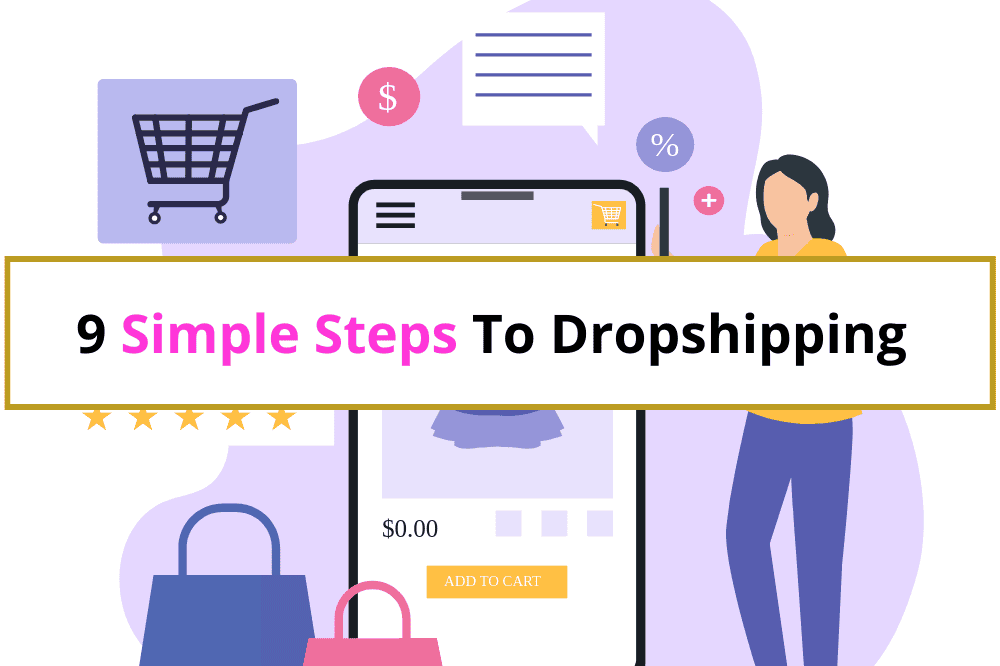A dropshipping business is a fantastic, and very popular, choice for women to allow them to start an online business and earn money from home
So if this sounds good, let me show you the basic steps to get started…
 This post may contain affiliate links. Please see my disclaimer for more information.
This post may contain affiliate links. Please see my disclaimer for more information.
Setting up a dropshipping business has become an attractive venture for aspiring woman entrepreneurs due to its low startup costs and flexibility.
I’ve actually done a stint of dropshipping myself, so I do have some knowledge and experience with this online business.
So here’s a quick rundown of the steps you need to take to start your own dropshipping business.
1. Understanding the Dropshipping Model
Dropshipping is a retail fulfillment method where a store doesn’t keep the products it sells in stock. Instead, when you sell a product, you purchase the item from a third party – typically a wholesaler or manufacturer – and have it shipped directly to the customer.
Related Reading: What Exactly is Dropshipping
As a result, you never handle the product directly. This model significantly reduces the risks associated with traditional retail, such as holding large amounts of inventory.
2. Choosing a Niche / Products
Choosing the right niche is critical to the success of your dropshipping business. A niche is a specific segment of the market that you will target with your products.
Tip: Auto DS* has a built-in system to help you choose profitable products.
* Automated Dropshipping
Here are some tips to help you choose a profitable niche:
- Passion and Interest: Select a niche you are passionate about. Your enthusiasm will keep you motivated and help you connect with your audience.
- Market Demand: Use tools like Google Trends, keyword research, and social media platforms to gauge demand for your chosen niche.
- Competition Analysis: Research your competition. High competition can indicate a profitable niche, but it also means you’ll need a strong strategy to stand out.
- Profitability: Consider the profit margins. Products that are cheap to source but can be sold at a higher price point are ideal.
3. Conducting Market Research
Market research is crucial to understanding your target audience, their needs, and how you can serve them better than your competitors.
Here’s how to conduct effective market research:
- Customer Surveys: Use surveys and questionnaires to gather insights directly from potential customers.
- Competitor Analysis: Analyze competitors’ websites, product offerings, pricing strategies, and customer reviews.
- Social Media Listening: Monitor social media platforms to see what people are saying about similar products and identify trends and pain points.
4. Finding Reliable Suppliers
Reliable suppliers are the backbone of a successful dropshipping business.
Here’s how to find and vet potential suppliers:
- Supplier Directories: Use directories like AliExpress, Oberlo, and SaleHoo to find verified suppliers.
- Trade Shows: Attend trade shows to meet suppliers in person and evaluate their products.
- Samples: Order samples from potential suppliers to assess product quality, shipping times, and packaging.
- Reviews and References: Check online reviews and ask for references from other businesses that have worked with the supplier.
5. Setting Up Your E-Commerce Store
Your e-commerce store is where customers will interact with your brand and make purchases.
Here’s how to set it up:
- Choose a Platform: Popular platforms like Shopify, WooCommerce, and BigCommerce offer user-friendly interfaces and a range of customization options.
- Design Your Store: Choose a clean, professional design that reflects your brand. Ensure your website is mobile-friendly and easy to navigate.
- Add Products: Import products from your suppliers, including high-quality images, detailed descriptions, and pricing information.
- Set Up Payment Methods: Integrate secure payment gateways such as PayPal, Stripe, or credit card processors to handle transactions.
6. Creating a Marketing Strategy
A solid marketing strategy is essential for driving traffic to your store and converting visitors into customers.
Here are some effective marketing tactics:
- Search Engine Optimization (SEO): Optimize your website content to rank higher in search engine results. Use relevant keywords, create high-quality content, and build backlinks.
- Social Media Marketing: Use platforms like Instagram, Facebook, and Pinterest to promote your products, engage with your audience, and build brand awareness.
- Email Marketing: Build an email list and send regular newsletters, promotional offers, and product updates to keep your audience engaged.
- Paid Advertising: Invest in pay-per-click (PPC) advertising through Google Ads or social media ads to reach a wider audience quickly.
- Content Marketing: Create valuable content, such as blog posts, videos, and infographics, that addresses your audience’s pain points and showcases your expertise.
7. Managing Orders and Customer Service
Efficient order management and excellent customer service are crucial for retaining customers and building a reputable brand.
Tip: AutoDS helps you automate fulfilling your orders
Here’s how to manage these aspects effectively:
- Order Processing: Use automation tools to streamline order processing. Ensure orders are forwarded to suppliers promptly and track shipments to avoid delays.
- Inventory Management: Regularly communicate with your suppliers to keep track of stock levels and avoid selling out-of-stock items.
- Customer Support: Provide multiple channels for customer support, such as email, live chat, and phone. Respond promptly to inquiries and resolve issues swiftly.
- Returns and Refunds: Establish a clear return and refund policy. Work closely with your suppliers to manage returns efficiently.
8. Monitoring and Optimizing Performance
Regularly monitoring and optimizing your store’s performance is key to long-term success.
Here’s how to do it:
- Analytics: Use tools like Google Analytics and your e-commerce platform’s built-in analytics to track key metrics such as traffic, conversion rates, and average order value.
- Customer Feedback: Collect feedback from customers to identify areas for improvement. Use surveys, reviews, and direct communication to gather insights.
- A/B Testing: Conduct A/B tests on various elements of your website and marketing campaigns to determine what works best for your audience.
- Performance Reports: Create regular performance reports to track progress and make data-driven decisions for future strategies.
9. Legal and Financial Considerations
Running a dropshipping business involves several legal and financial considerations.
Here’s what you need to know:
- Business Structure: Choose a legal structure for your business, such as sole proprietorship, LLC, or corporation. Each has its own implications for liability and taxes.
- Licenses and Permits: Depending on your location, you may need business licenses or permits to operate legally.
- Taxes: Understand your tax obligations, including sales tax and income tax. Consult with a tax professional to ensure compliance.
- Terms and Conditions: Clearly outline your store’s terms and conditions, including return policies, shipping policies, and privacy policies.
Conclusion
Setting up a dropshipping business can be a rewarding venture with the right approach.
By choosing a profitable niche, conducting thorough market research, partnering with reliable suppliers, and implementing effective marketing strategies, you can build a successful online store.
Remember to continuously monitor and optimize your performance, provide excellent customer service, and stay compliant with legal and financial regulations.
With dedication and strategic planning, your dropshipping business can thrive in the competitive e-commerce landscape.
Learn more about starting your own dropshipping business and how to automate it so you can earn passive income.
Hi, I’m Claire Bullerwell
I’ve ran dozens of home-based businesses, both offline and online, since my early twenties. I started this blog to share all my wealth of knowledge and experience to help women just like you; to find your dream home business and to live your best life.
Follow me and let’s get acquainted…



